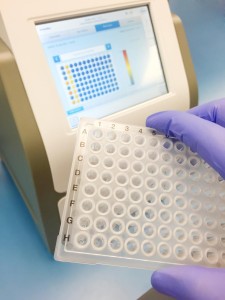Dye-based qPCR assays, such as SYBR® Green and EvaGreen®, have many advantages over probe-based qPCR assays. Dye-based systems are desirable because they are highly adaptable, cost effective, and time efficient. qPCR specificity, however, is a vital factor to consider when using dye-based qPCR assays. The dyes can bind to any double strand DNA, regardless of whether it is the desired qPCR product, a non-specific amplification, or a primer dimer.
Low specificity is mainly caused by non-specific binding of primers, which includes binding to similar sequences in the DNA template at random locations, binding between primers, and primer self-binding. In addition to careful primer design to exclude undesired primer complimentarity, there are many other ways to improve qPCR specificity. The most effective way to improve specificity is to design primers about 23-26 nucleotides long, with a high annealing temperature (Tm) around 65°C. This is especially important when using genomic DNA or cDNA libraries as PCR templates. Longer primers with higher Tm can exponentially reduce the chance of the primers binding to the wrong location. Additionally, specificity can be increased by limiting the amplicon length to 100-200 nucleotides and shortening the qPCR annealing and elongation time in the qPCR program. A shorter qPCR annealing and elongation time will avoid the amplification of long, undesired amplicons. Furthermore, use of PCR polymerases with “hot-start” capability will significantly reduce the chance of forming primer dimers, as no “leakage” amplification will start before the binding of primers to the proper locations.
When working with cDNA libraries, one critical factor to consider is the location of primers on the cDNA. It is recommended to design primers at the exon-exon junction to reduce the risk of amplification of genomic DNA. In addition, many genes have multiple transcript variants. Picking amplicons in one common region shared by all variants is important when comparing expression profiling among samples containing different variants. Traditional PCR methods to increase specificity, such as changing cation and/or DMSO concentrations, are not recommended for qPCR assays. These alterations can introduce variation and error into the system, and may make quantification problematic.
Designing robust primers for qPCR is a time-consuming and complicated process that requires expertise. To provide a simple, fast, and powerful approach to study gene expression profiles, ScienCell now offer GeneQueryTM qPCR Array Kits, Individual Primer Sets and Custom Primer Design Service for gene expression profiling. All primers designed by our experts ensure that: (i) the optimal annealing temperature in qPCR analysis is 65°C (with 2 mM Mg2+, and no DMSO); (ii) the primer set recognizes all known transcript variants of target gene, unless otherwise indicated; and (iii) only one gene is amplified. Furthermore, all primer sets have been validated by both qPCR with melt curve analysis and gel electrophoresis for high specificity.
More information: https://sciencellonline.com/products-services/genetics-genomics/
Questions? Email info@sciencellonline.com

